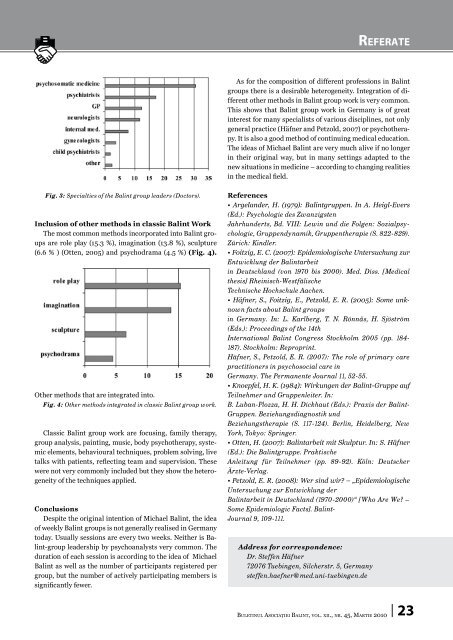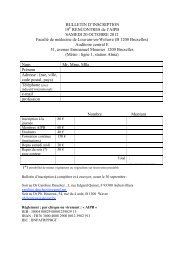ReferateAs for the composition of different professions in Balintgroups there is a desirable heterogeneity. Integration of differentother methods in Balint group work is very common.This shows that Balint group work in Germany is of greatinterest for many specialists of various disciplines, not onlygeneral practice (Häfner and Petzold, 2007) or psychotherapy.It is also a good method of continuing medical education.The ideas of Michael Balint are very much alive if no longerin their original way, but in many settings adapted to thenew situations in medicine – according to changing realitiesin the medical field.Fig. 3: Specialties of the Balint group leaders (Doctors).Inclusion of other methods in classic Balint WorkThe most common methods incorporated into Balint groupsare role play (15.3 %), imagination (13.8 %), sculpture(6.6 % ) (Otten, 2005) and psychodrama (4.5 %) (Fig. 4).Other methods that are integrated into.Fig. 4: Other methods integrated in classic Balint group work.Classic Balint group work are focusing, family therapy,group analysis, painting, music, body psychotherapy, systemicelements, behavioural techniques, problem solving, livetalks with patients, reflecting team and supervision. Thesewere not very commonly included but they show the heterogeneityof the techniques applied.ConclusionsDespite the original intention of Michael Balint, the ideaof weekly Balint groups is not generally realised in Germanytoday. Usually sessions are every two weeks. Neither is Balint-groupleadership by psychoanalysts very common. Theduration of each session is according to the idea of MichaelBalint as well as the number of participants registered pergroup, but the number of actively participating members issignificantly fewer.References• Argelander, H. (1979): Balintgruppen. In A. Heigl-Evers(Ed.): Psychologie des ZwanzigstenJahrhunderts, Bd. VIII: Lewin und die Folgen: Sozialpsychologie,Gruppendynamik, Gruppentherapie (S. 822-829).Zürich: Kindler.• Foitzig, E. C. (2007): Epidemiologische Untersuchung zurEntwicklung der Balintarbeitin Deutschland (von 1970 bis 2000). Med. Diss. [Medicalthesis] Rheinisch-WestfälischeTechnische Hochschule Aachen.• Häfner, S., Foitzig, E., Petzold, E. R. (2005): Some unknownfacts about Balint groupsin Germany. In: L. Karlberg, T. N. Rönnås, H. Sjöström(Eds.): Proceedings of the 14thInternational Balint Congress Stockholm 2005 (pp. 184-187). Stockholm: Reproprint.Häfner, S., Petzold, E. R. (2007): The role of primary carepractitioners in psychosocial care inGermany. The Permanente Journal 11, 52-55.• Knoepfel, H. K. (1984): Wirkungen der Balint-Gruppe aufTeilnehmer und Gruppenleiter. In:B. Luban-Plozza, H. H. Dickhaut (Eds.): Praxis der Balint-Gruppen. Beziehungsdiagnostik undBeziehungstherapie (S. 117-124). Berlin, Heidelberg, NewYork, Tokyo: Springer.• Otten, H. (2007): Balintarbeit mit Skulptur. In: S. Häfner(Ed.): Die Balintgruppe. PraktischeAnleitung für Teilnehmer (pp. 89-92). Köln: DeutscherÄrzte-Verlag.• Petzold, E. R. (2008): Wer sind wir? – „EpidemiologischeUntersuchung zur Entwicklung derBalintarbeit in Deutschland (1970-2000)“ [Who Are We? –Some Epidemiologic Facts]. Balint-Journal 9, 109-111.Address for correspondence:Dr. Steffen Häfner72076 Tuebingen, Silcherstr. 5, Germanysteffen.haefner@med.uni-tuebingen.deBuletinul Asociaţiei Balint, vol. xii., nr. 45, Martie <strong>2010</strong>23
ReferateTHE PHYsiciAN AssisTANT – PATIENT RELATIOnsHIP DEscriBED BY A CERTIFIED PARelaţia dintre asisTEntul medicului şipacient descrisă de un “asisTEnt de medic”- Matthew Uhde – Student doctor, College of Osteopathic Medicine, NovaSoutheastern University (Introducere explicativă şi rezumat în româneşte de Almoş Bela Trif )Almoș Bela TrifTermenul de „physician assistant (PA)” se poatetraduce în româneşte cel mai simplu ca „asistent demedic”, pentru a evita o dublă confuzie.În primul rând e vorba de confuzia cu profesiunea de„asistent medical”, care în România este asimilată cu profesiuneade „registered nurse (RN)” din lumea anglo-saxonă.În al doilea rând, termenul de „medical assistant” înSUA şi Australia desemnează o altă meserie -mult mai puţinspecializată decât cea de „asistent medical” sau „sorămedicală” din România, similară cu cea de „registrator medical”,profesie care la rândul ei se deosebeşte de profesia de„medical registraar” din Anglia şi Australia.Am simţit nevoia unei asemenea introduceri explicativedeoarece există numeroşi „false friends”, ce te induc îneroare în terminologia folosită curent pentru a denumiprofesiunile reunite sub numele generic de „health careproviders”, care s-ar pute traduce cu românescul „lucrătoriîn domeniul sănătăţii”, sau chiar cu mai învechitul termende „muncitorii sanitari”. Veşnica pomenire a celebrei gazeteromâneşti - de o înaltă ţinută ştiinţifică, morală şi educativă– „Muncitorul sanitar”!Studiind de mai mulţi ani bioetica, etica practicii medicale,burnout-ul medicului, relaţia medic–pacient şi grupulBalint ca o metodă de îmbunătăţire a „relaţiei medic,soră medicală, psiholog-pacient”, am început câteva liniide cercetare cu studenţii din Universitatea în care lucrez.Bineînţeles că pe lângă studenţii de la stomatologie, optometrie,medicina osteopatică şi farmacie, am întâlnit studenţiicare urmau cursurile de „nursing” şi de „physicianassitant”. Treptat am înţeles curriculum pe care îl urmaeză24Buletinul Asociaţiei Balint, vol. xii., nr. 45, Martie <strong>2010</strong>aceste linii de studiu, dar eram încă nelămurit, ce face înviaţa de toate zilele un „physician assistant”, adică unPA aşa cum se spune pe aici, în SUA.Matt, unul dintre studenţii cam cu zece ani mai în vârstădecât studenţii abia ieşiţi din colegii, mi-a mărturisit că alucrat ca PA timp de 8 ani de zile, aşa că l-am rugat să scrieceva despre viaţa lui ca „asistent de medic” şi despre relaţiasa cu pacienţii, ca să îmi pot face o opinie informată asuprarelaţiei „asistent de medic - pacient”.El a compus un material original, plin de o savuroasăonestitate, pe care l-am considerat util a fi publicat în revistanoastră, ca un model de „modus operandi” al unei profesiimai puţin cunoscute în România.În rândurile care urmează el explică mai întăi ce este unPA, unde a studiat el însuşi şi cum s-a angajat prima dată.Mai apoi, el descrie caracteristicele muncii de zi cu zi şi rolulunui asistent de medic în activitatea unui serviciu. Cuo notă umoristică el menţionează că activitatatea unui PApoate fi diferită în funcţie de dorinţa de afirmare personalăa acestuia, de bunăvoinţa sa şi de caracteristicile serviciuluicare l-a angajat.Pasajele unde Matt descrie relaţia sa directă cu pacienţiisunt cele mai plăcute de citit, el având grijă să scoată înevidenţă faptul că, spre deosebire de medicul specialist saude cel ultra-specializat, asistentul de medic îşi poate dedicamai mult timp discuţiei cu pacientul. E nevoie să ne amintimcă aceasta era chiar sugestia lui Michael Balint însuşi,când se adresa medicilor de medicină generală din Londrala vremea sa.Pe de alta parte, Matt afirmă cu modestie că asistentulde medic nu e nicidecum primadona unui serviciu chirurgical.El arată cu claritate, cum PA pot fi însărcinaţi cu procedurimici de rutină, de aşa manieră încât chirurgii vor aveamai mult timp să se dedice procedurilor complicate.Un paragraf întreg este dedicat avantajelor profesiuniide asistent de medic, principalul dintre ele fiind posibilitateade a face cunoştinţă cu mai multe domenii ale practiciimedicale, ceea ce stimulează creativitatea. Totodata elmenţionează limitele unor asemenea treceri de la o disciplinăla alta.Experienţa sa în departamentul de urgenţe spitaliceştiîi prilejuieşte lui Matt o interesantă descriere a sistemuluide funcţionare a unui atare serviciu în USA, în care timpul



